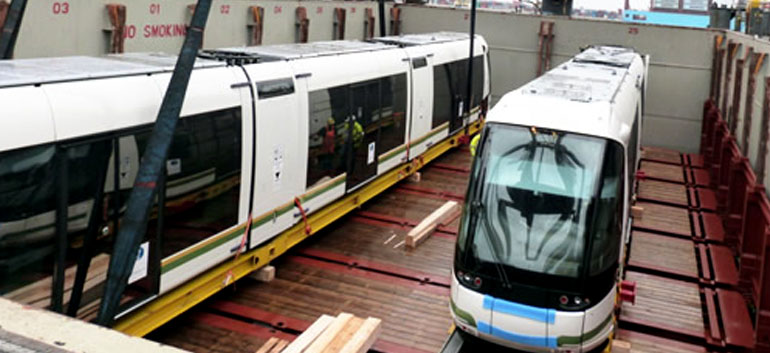The first in a series of modern streetcar trolleys arrived Sunday in Medellin, Colombia’s second largest city, after 28 days in transit from Belgium, local media reported on Monday.
A new car is set to be shipped every 20 days for the next seven months, according to officials, with 11 more cars expected to arrive before March 2015 as part of the city’s new Tranvia public transportation project.
“It’s an important milestone; its arrival to the city demonstrates that the project is advancing, that it’s sticking to the schedule, and that everything is happening as it should,” said Medellin Secretary of Infrastructure Javier Dario Toro.
Speaking to the local El Colombiano newspaper, Medellin Mayor Anibal Gaviria has previously expressed his excitement about the train’s arrival. “To see these cars here, tangible, is going to be exciting, and will generate confidence {in the project].”
Several years in the making, the Ayacucho Tranvia line would connect the San Antonio metro hub in downtown Medellin to the Alejandro Echavarria neighborhood in the eastern mountains, according to the city government’s website, passing through districts 8, 9 and 10, along a series of yet-to-be constructed trolley stations.
The project represents another sizable transportation investment for Medellin, which was named the Urban Land Institute’s “Most Innovative City in the World” in 2013, largely on the back of the successes of the city’s new metro line and cable car system. The cable car in particular has greatly increased mobility for residents of poorer, previously isolated neighborhoods along Medellin’s eastern mountains, one of the primary goals of the Tranvia project, as well.
Medellin public transportation also received an international award in 2011 from Cities For Mobility.
MORE: Medellin receives international award for public transportation
Originating from Belgium, the cars are said to be state of the art. Operating on wheels rather than a rail system, the cars are “ideal for steep climbs such as the hills around the section where we will operate,” according to Carlos Ortiz, director of metro planning, allowing for better breaking.
Ortiz went on to tell El Colombiano that the line, as a whole, could be up and running as early as next year. “We are in the stage of assembling, attachments, inspections, and tests to have [the system] functioning by 2015,” he said.
Public Transportation Protests
Success with Medellin’s metros and the Tranvia project contrasts sharply with the state public transportation in much of the nation. In February, 2,000 protestors marched in Cali in an effort to draw attention to the shortcomings of the city’s mass transit system.
MORE: Protesters march in Cali for integrated public transport
A surge of massive public transportation protests took place earlier this year in Bogota, with the national Inspector General investigating some of the protests that turned violent.
MORE: Bogota paralyzed amid public transport protests
Bogota’s Mayor Gustavo Petro spoke to protestors in March and while encouraging the protests, also promised changes to Bogota’s ailing transportation system.
MORE: Bogota Mayor calls for new public transport protest
Sources
- El primero de 11 carros del Tranvía ya está en Medellín (El Colombiano)
- Tras 28 días de viaje en barco, un carro del tranvía llega a Medellín (El Colombiano)
- Socialización del tranvía de Ayacucho (Medellin government website)


